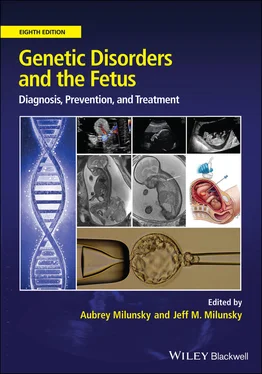Genetic Disorders and the Fetus
Здесь есть возможность читать онлайн «Genetic Disorders and the Fetus» — ознакомительный отрывок электронной книги совершенно бесплатно, а после прочтения отрывка купить полную версию. В некоторых случаях можно слушать аудио, скачать через торрент в формате fb2 и присутствует краткое содержание. Жанр: unrecognised, на английском языке. Описание произведения, (предисловие) а так же отзывы посетителей доступны на портале библиотеки ЛибКат.
- Название:Genetic Disorders and the Fetus
- Автор:
- Жанр:
- Год:неизвестен
- ISBN:нет данных
- Рейтинг книги:4 / 5. Голосов: 1
-
Избранное:Добавить в избранное
- Отзывы:
-
Ваша оценка:
- 80
- 1
- 2
- 3
- 4
- 5
Genetic Disorders and the Fetus: краткое содержание, описание и аннотация
Предлагаем к чтению аннотацию, описание, краткое содержание или предисловие (зависит от того, что написал сам автор книги «Genetic Disorders and the Fetus»). Если вы не нашли необходимую информацию о книге — напишите в комментариях, мы постараемся отыскать её.
Genetic Disorders and the Fetus — читать онлайн ознакомительный отрывок
Ниже представлен текст книги, разбитый по страницам. Система сохранения места последней прочитанной страницы, позволяет с удобством читать онлайн бесплатно книгу «Genetic Disorders and the Fetus», без необходимости каждый раз заново искать на чём Вы остановились. Поставьте закладку, и сможете в любой момент перейти на страницу, на которой закончили чтение.
Интервал:
Закладка:
Box 1.1Factors that influence estimates of the incidence or prevalence in the newborn of a congenital malformation (CM) or genetic disorder
Availability and use of expertise in prenatal diagnostic ultrasound and MRI
Accuracy of diagnosis
Age at diagnosis
Case selection, bias, and ascertainment
Congenital hypothyroidism
Consanguinity
Definitions of major and minor congenital anomalies
Diagnostic DNA analysis
Duration of follow‐up
Economic level in developed or developing world
Environmental toxins
Family history
Frequency, inclusion, and exclusion of stillbirths, fetal deaths, and elective pregnancy termination
Frequency of certain infectious diseases
Frequency of de novo gene mutations
History of recurrent spontaneous abortion
In vitro fertilization
Incidence and severity of prematurity
Infertility
Intracytoplasmic sperm injection
Later manifestation or onset of disorder
Maternal age
Maternal alcohol abuse
Maternal diabetes and gestational diabetes
Maternal diet
Maternal epilepsy, lupus erythematosus and other illnesses
Maternal fever or use of hot tub in the first 6 weeks of pregnancy
Maternal folic acid supplementation
Maternal grandmother's age
Maternal obesity
Maternal serum screening for chromosome abnormalities
Maternal smoking
Maternal‐specific susceptibility genes
Maternal use of medication
Mortality rates decreasing
Multiple pregnancy rate
Necropsy
Noninvasive prenatal testing using cell‐free fetal DNA for chromosomal abnormalities and monogenic disorders
Parent with a congenital abnormality or genetic disorder
Paternal age
Previous affected child
Previous maternal immunization/vaccination
Season of the year
Training and expertise in examination of newborns
Use of chromosomal analysis
Use of chromosomal microarray
Use of whole‐exome sequencing
Use of whole‐genome sequencing
Use of death certificates
Use of registry data
Incidence and prevalence of genetic disorders and congenital malformations
Estimates of aneuploidy in oocytes and sperm reach 25 percent and 3–4 percent, respectively. 14 , 15Estimates, especially for oocytes, vary widely (see Chapter 2). The effect of maternal age, among other factors, is important. At 25 years, early thirties, and >40 years of age, the rate of aneuploidy approximates 5 percent, 10–25 percent, and 50 percent, respectively. 15 – 19Estimates of aneuploidy and structural chromosomal abnormalities in sperm vary from 7 to 14 percent. 20Not surprisingly, then, about one in 13 conceptions results in a chromosomally abnormal conceptus, 21while about 50 percent of first‐trimester spontaneous abortions are associated with chromosomal anomalies. 22One study of blastocysts revealed that 56.6 percent were aneuploid. Moreover, these blastocysts produced in vitro from women of advanced maternal age also revealed mosaicism in 69.2 percent. 23Similar results have been reported by others. 24Clinically significant chromosomal defects occur in 0.65 percent of all births; an additional 0.2 percent of babies are born with balanced structural chromosome rearrangements that have implications for reproduction later in life (see Chapters 11and 13). Between 5.6 and 11.5 percent of stillbirths and neonatal deaths have chromosomal defects. 25
Congenital malformations with obvious structural defects are found in about 2 percent of all births. 26This was the figure in Spain among 710,815 livebirths, 27with 2.25 percent in Liberia, 282.03 percent in India, 29and 2.53 percent among newborn males in Norway. 30The Mainz Birth Defects Registry in Germany in the 1990–1998 period reported a 6.9 percent frequency of major malformations among 30,940 livebirths, stillbirths, and abortions. 31Pooled data from 12 US population‐based birth defects surveillance systems, which included 13.5 million livebirths (1999–2007), revealed that American Indians/Alaska natives had a ≥50 percent greater prevalence for seven congenital malformations (including anotia or microtia, cleft lip, trisomy 18, encephalocele, limb‐reduction defect). 32Factors that had an impact on the incidence/prevalence of congenital malformations are discussed later.
Over 25,500 entries for genetic disorders and traits have been catalogued. 2Estimates based on 1 million consecutive livebirths in Canada suggested a monogenic disease in 3.6 in 1,000, consisting of autosomal dominant (1.4 in 1,000), autosomal recessive (1.7 in 1,000), and X‐linked recessive disorders (0.5 in 1,000). 33Baseline birth prevalence of rare single‐gene disorders for multiple countries are shown in Figure 1.1, which highlights the contribution of consanguinity‐associated disorders. 34Polygenic disorders occurred at a rate of 46.4 in 1,000 ( Table 1.1). A key study of homozygosity in consanguineous patients with an autosomal recessive disease showed that, on average, 11 percent of their genomes were homozygous. 35Each affected individual had 20 homozygous segments exceeding 3 cM.

Figure 1.1 Total baseline birth prevalence of rare single‐gene disorders by World Health Organization (WHO) region, highlighting the important contribution of consanguinity to monogenic disorders.
Source: Blencowe et al. 2018. 34Reproduced with permission from Springer.
Table 1.1 The frequencies of genetic disorders in 1,169,873 births, 1952–1983 34.
| Category | Rate per million livebirths | Total births (percent) |
|---|---|---|
| A | ||
| Dominant | 1,395.4 | 0.14 |
| Recessive | 1,665.3 | 0.17 |
| X‐linked | 532.4 | 0.05 |
| Chromosomal | 1,845.4 | 0.18 |
| Multifactorial | 46,582.6 | 4.64 |
| Genetic unknown | 1,164.2 | 0.12 |
| Total | 53,175.3 | 5.32 a |
| B | ||
| All congenital anomalies 740–759 b | 52,808.2 | 5.28 |
| Congenital anomalies with genetic etiology (included in section A) | 26,584.2 | 2.66 |
| C | ||
| Disorders in section A plus those congenital anomalies not already included | 79,399.3 | 7.94 |
aSum is not exact owing to rounding.
bInternational Classification of Disease numbers.
Source: Blencowe et al. 2018. 34With permission from Elsevier.
At least 3–4 percent of all births are associated with a major congenital defect, intellectual disability, or a genetic disorder, a rate that doubles by 7–8 years of age, given later‐appearing and/or later‐diagnosed genetic disorders. 36 , 37If all congenital defects are considered, Baird et al. 33estimated that 7.9 percent of liveborn individuals have some type of genetic disorder by about 25 years of age. These estimates are likely to be very low given, for example, the frequency of undetected defects such as bicuspid aortic valves that occur in 1–2 percent of the population. 38The bicuspid aortic valve is the most common congenital cardiac malformation and in the final analysis may cause higher mortality and morbidity rates than all other congenital cardiac defects. 39About 27 percent suffer cardiovascular complications requiring surgery. 40 , 41Mitral valve prolapse affects 2–3 percent of the general population, involving more than 176 million people worldwide. 42A Canadian study of 107,559 patients with congenital heart disease reported a prevalence of 8.21 per 1,000 livebirths, rising to an overall prevalence of 13.11 per 1,000 in adults. 43The authors concluded that adults now account for some two‐thirds of the prevalence of congenital heart disease. Categorical examples of factors associated with an increased risk of congenital heart disease or malformations in the fetus are shown in Box 1.1. A metropolitan Atlanta study (1998–2005) showed an overall prevalence of 81.4 per 10,000 for congenital heart disease among 398,140 livebirths, 44similar to a Belgian study of 111,225 live and stillborn infants ≥26 weeks of gestation with an incidence of 0.83 percent, chromosome abnormalities excluded. 45A EUROCAT registry study found an increasing prevalence of severe congenital heart defects (single ventricle, atrioventricular septal defects, and tetralogy of Fallot) possibly due to increasing obesity and diabetes. 46In a study of 8,760 patients with autism spectrum disorders and 26,280 controls, a statistically significant increase in the odds of concurrent congenital heart disease (odds ratio [OR] 1.32) was noted. 47Atrial septal defects and ventricular septal defects were most common.
Читать дальшеИнтервал:
Закладка:
Похожие книги на «Genetic Disorders and the Fetus»
Представляем Вашему вниманию похожие книги на «Genetic Disorders and the Fetus» списком для выбора. Мы отобрали схожую по названию и смыслу литературу в надежде предоставить читателям больше вариантов отыскать новые, интересные, ещё непрочитанные произведения.
Обсуждение, отзывы о книге «Genetic Disorders and the Fetus» и просто собственные мнения читателей. Оставьте ваши комментарии, напишите, что Вы думаете о произведении, его смысле или главных героях. Укажите что конкретно понравилось, а что нет, и почему Вы так считаете.












